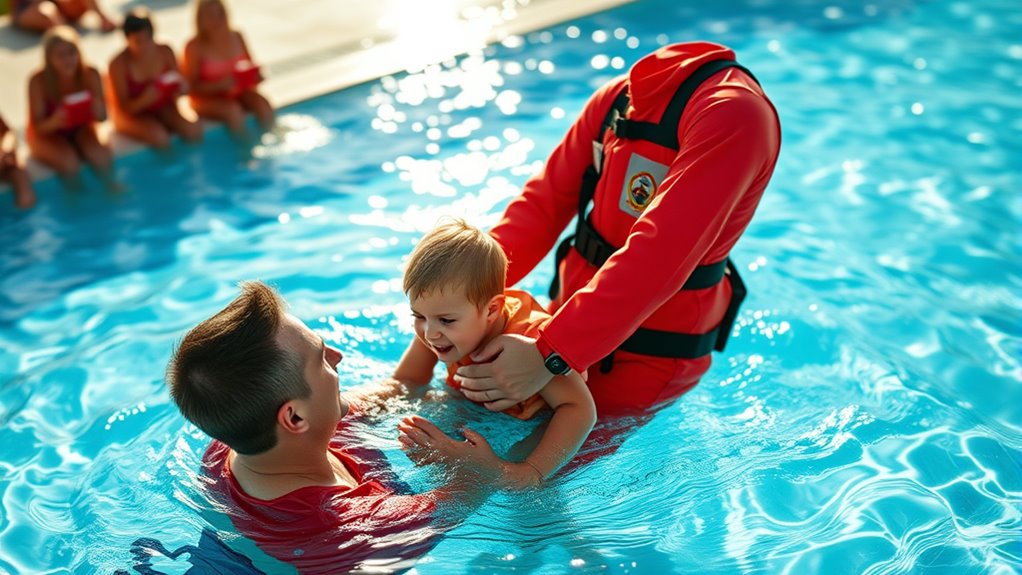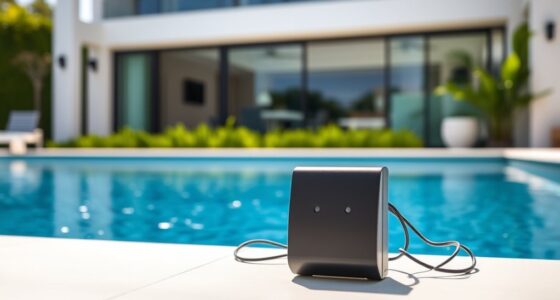If you witness a pool accident, first confirm the scene is safe, checking for hazards before entering. Recognize signs like struggling or unconsciousness, then call emergency services loudly and clearly. If the swimmer is unresponsive, start CPR immediately, supporting their head and delivering chest compressions along with rescue breaths if trained. Use rescue equipment properly and provide first aid for wounds while monitoring their condition. Continue until help arrives; more detailed steps can guide you in critical moments.
Key Takeaways
- Recognize signs of drowning or distress and ensure scene safety before attempting rescue.
- Call emergency services immediately and use proper rescue equipment following manufacturer instructions.
- Perform CPR if the victim is unresponsive and not breathing, maintaining chest compressions at 100-120 per minute.
- Apply first aid for bleeding or wounds with gloves, direct pressure, and sterile dressings; monitor victim continuously.
- Prevent future incidents through safety measures, proper equipment handling, and maintaining a safe pool environment.
Recognizing the Signs of a Pool Emergency

Recognizing the signs of a pool emergency quickly can make the difference between a rescue and a tragedy. Watch for swimmers who suddenly struggle to breathe or appear panicked, as they may be in distress. If someone is not surfacing or seems to be sinking unexpectedly, it’s a clear warning sign of trouble. Look for individuals clinging to the pool’s edge or trying to hold onto floatation devices without success. Unusual behaviors like gasping, flailing, or rapid movements can indicate distress. Also, notice if a swimmer suddenly becomes still or unconscious. The moment you spot these signs, you must act immediately. Early recognition helps prevent a situation from escalating, giving you the best chance to respond effectively and save lives. Additionally, understanding projector technology can help in educational efforts for safety and emergency preparedness around pools.
Ensuring Scene Safety Before Acting

Before helping someone, make sure the scene is safe for you to enter. Look around for hazards like broken glass, electrical equipment, or slippery surfaces, and remove them if you can. Ensuring the area is secure protects both you and the victim from further harm.
Assess Surroundings Carefully
To guarantee your safety and effectively help during a pool emergency, you must carefully assess the scene before taking action. Look around for any immediate dangers, such as broken glass, electrical hazards, or unstable structures. Check if the water conditions are safe for entry—are there strong currents or obstacles? Ensure that other people aren’t putting themselves at risk or causing chaos. Observe the position of the victim to determine the best way to approach. Be mindful of your surroundings, including slippery surfaces, pool equipment, or debris that could cause slips or injuries. Staying alert helps prevent additional accidents and makes sure you can focus on providing safe, effective assistance. Always prioritize scene safety before jumping in to help.
Remove Hazards Immediately
When you arrive at the scene of a pool emergency, your first priority is to remove any hazards that could cause further injuries. Look around quickly for objects like pool toys, furniture, or debris that might trip or injure someone. If possible, turn off the pool’s power to prevent electrical hazards. Make certain the area is stable before entering, checking for broken glass, sharp edges, or unstable structures. Be cautious of slippery surfaces to avoid falls. Remove or secure any obstacles that could impede rescue efforts or pose additional risks. Remember, your safety is vital to effectively help others. Clearing hazards immediately helps create a safer environment, allowing you to focus on providing aid without risking further injuries.
Calling for Professional Help Effectively

In an emergency, quickly and clearly calling for professional help can make all the difference. Stay calm and speak loudly, providing essential details like your location, the nature of the incident, and the number of victims. Use a phone with a clear signal, and avoid background noise when possible. If you’re unable to speak, leave a message or send a text if emergency services accept them. If someone else is nearby, ask them to call immediately. Don’t hang up until the dispatcher confirms they have all necessary information. Your goal is to guarantee responders understand the urgency and arrive prepared. Clear, concise communication helps emergency teams act swiftly and effectively, increasing the chances of a positive outcome for everyone involved. Practicing timing aids can help improve your delivery in high-pressure situations.
Performing CPR on an Unresponsive Victim
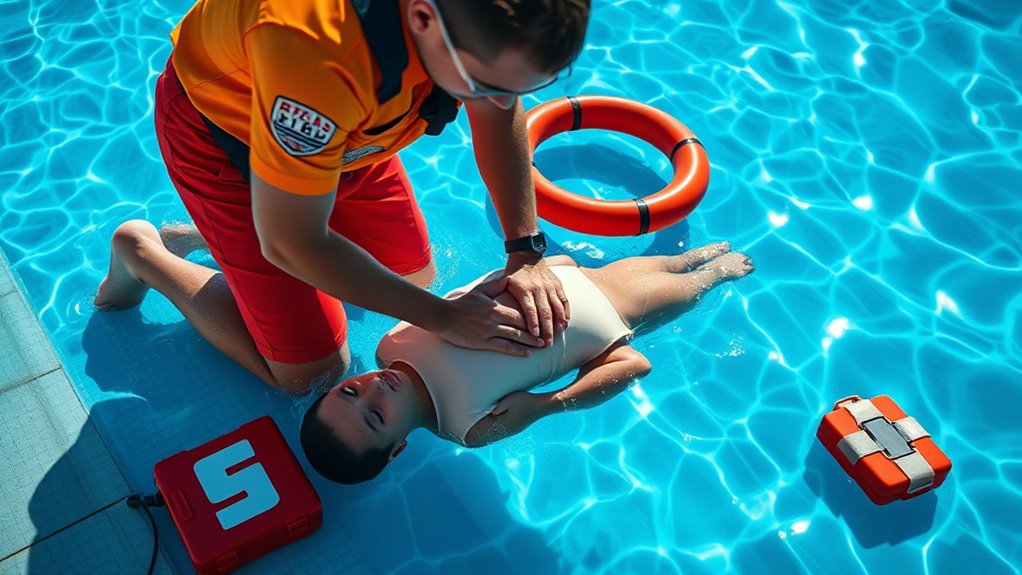
After calling for professional help, your immediate focus should shift to providing aid. Check if the victim is breathing. If not, start CPR immediately. Place the heel of your hand on the center of their chest, interlock your fingers, and keep your arms straight. Push hard and fast at a rate of about 100-120 compressions per minute. After 30 compressions, give 2 rescue breaths if you’re trained. Ensure the airway is open by tilting the head back. Continue cycles of 30 compressions and 2 breaths until help arrives or the victim shows signs of life. Regular use of CPR techniques can significantly improve survival chances in emergency situations. Incorporating proper tuning of your equipment can also enhance performance and reliability during critical moments.
Using Rescue Equipment Correctly
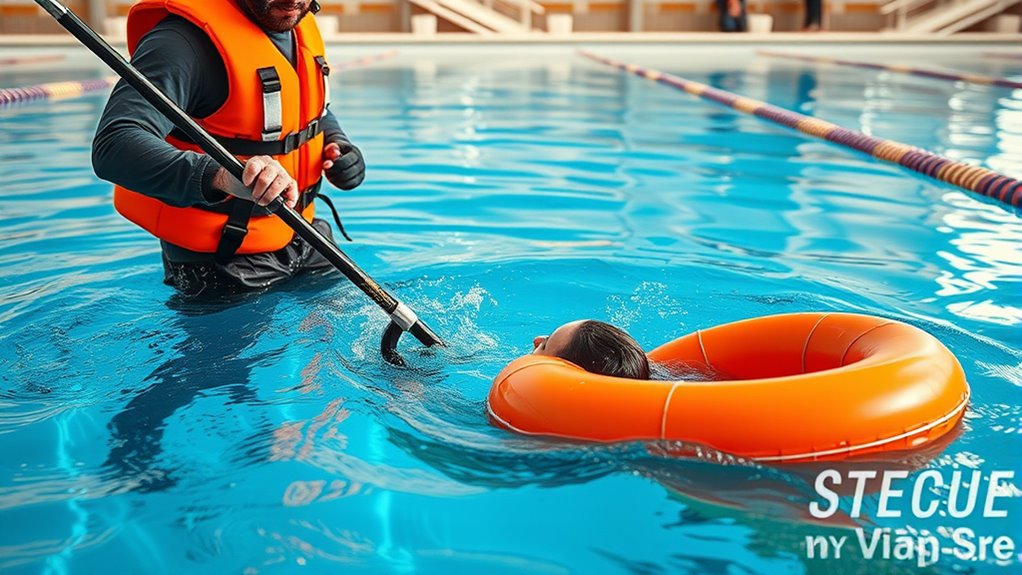
When using rescue equipment, you need to handle it properly to guarantee safety and effectiveness. Applying the correct rescue techniques can make a difference in saving a life. Let’s review how to handle equipment confidently and perform rescues efficiently. Proper project management support and ongoing training are essential to ensure responders are prepared for emergency situations.
Proper Equipment Handling
Using rescue equipment correctly is essential to guarantee both your safety and the safety of the person in distress. Always inspect your gear before use, checking for damage or defects that could compromise its effectiveness. When handling rescue equipment, use a firm grip and avoid unnecessary movements that could cause slips or drops. Keep the equipment close and organized to ensure quick access during an emergency. Follow manufacturer instructions for operation, avoiding shortcuts or improvisations. Be mindful of your surroundings, ensuring you don’t put yourself at risk while deploying the gear. Proper handling reduces the chance of injury and ensures the rescue device functions as intended. Remember, confident and precise equipment handling can make a critical difference during a rescue.
Effective Rescue Techniques
Proper equipment handling sets the foundation for effective rescue efforts, but knowing how to apply rescue techniques correctly is what truly saves lives. When approaching a drowning victim, ensure you maintain your own safety first. Use rescue equipment like reaching poles or throw ropes to keep a safe distance while assisting. Support the victim’s head and back as you lift them out of the water, avoiding unnecessary movement that could cause further injury. Communicate clearly with your team, coordinating your efforts smoothly. Once on land, check for responsiveness and breathing, providing first aid as needed. Mastering these techniques guarantees you respond swiftly and effectively, increasing the chances of a successful rescue and minimizing potential injuries. Always stay calm and act decisively.
Managing a Choking or Breathing Emergency
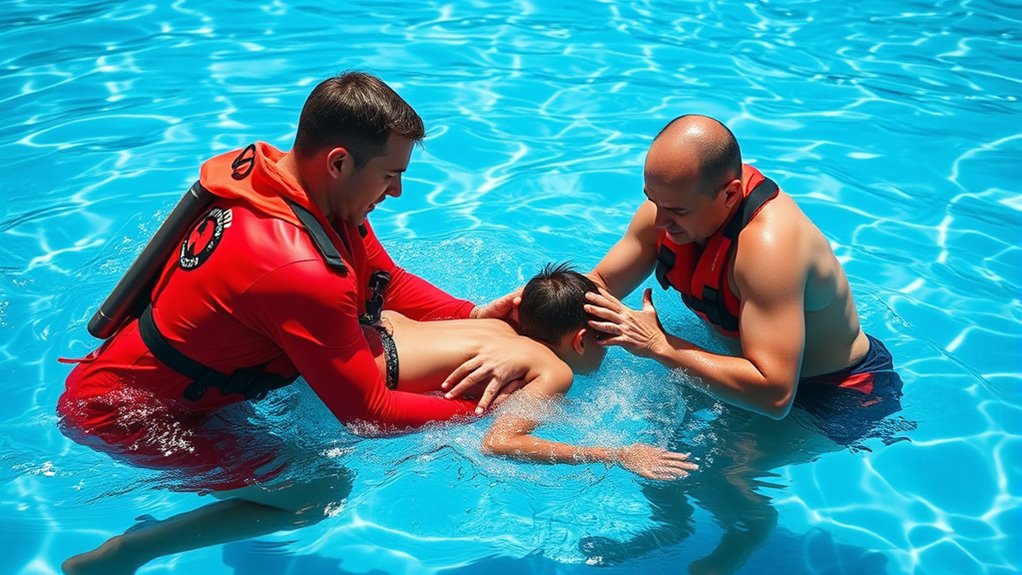
If someone is choking or struggling to breathe in the pool, quick action can make all the difference. First, call for emergency help immediately. Stay calm and encourage the person to cough if they can. If they can’t breathe or are unresponsive, carefully remove them from the water and begin rescue breathing if you’re trained. For a conscious person, perform back blows and abdominal thrusts to dislodge the object. For an unconscious person, start CPR with rescue breaths. Keep their head tilted slightly back to open the airway. Do not attempt to remove the object yourself unless it’s visible and easily accessible. Stay focused, act swiftly, and remember that timely intervention can save their life.
Providing First Aid for Wounds and Bleeding
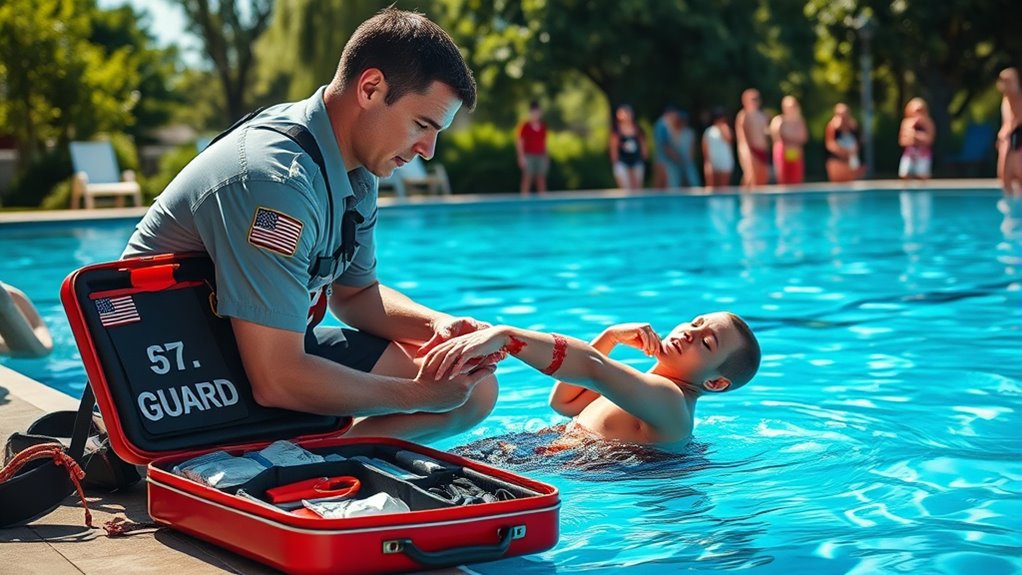
When someone is injured in the pool and bleeding, quick and effective first aid can prevent infection and control blood loss. First, put on gloves to protect yourself. Apply direct pressure to the wound with a clean cloth or sterile bandage to slow bleeding. If blood soaks through, add more layers without removing the initial cloth. Keep the injured person calm and still to prevent further injury. Elevate the affected limb if possible, as this can reduce bleeding. Avoid using tourniquets unless bleeding is severe and uncontrollable. Once bleeding slows or stops, clean the wound gently with clean water and cover it with a sterile dressing. Proper angle adjustment and leveling of pinball machines can also help prevent injuries during gameplay. Maintaining air purifier filters regularly can help improve indoor air quality, reducing airborne contaminants that might cause health issues. Regular maintenance of first aid supplies ensures readiness for emergencies. Additionally, staying informed about injury prevention strategies can further minimize risks during water activities. Proper storage and safety protocols for pool areas can also help prevent accidents and injuries. Seek medical attention if the wound is deep, large, or contaminated to guarantee proper care.
Monitoring and Supporting the Victim Until Help Arrives

How can you effectively monitor and support a victim until professional help arrives? First, keep the person afloat and stable, avoiding unnecessary movement that could worsen injuries. Continuously check their breathing and pulse, and be ready to perform CPR if needed. Stay calm and reassure them with a steady voice, letting them know help is on the way. Keep them warm with a blanket or clothing to prevent shock. Observe for any changes in their condition, such as difficulty breathing or unconsciousness, and relay this information to emergency responders. Never leave the victim alone, especially if they’re unresponsive. Your calm, attentive support can make a critical difference until trained medical personnel take over. Remember, fathers have a profound impact on children’s resilience and recovery in emergencies. Maintaining a safe environment around the victim is also essential to prevent further accidents or injuries.
Frequently Asked Questions
What Is the Best Way to Prevent Pool Accidents Altogether?
To prevent pool accidents, you should prioritize safety measures like constant supervision, especially for children. Make certain everyone knows to follow pool rules, such as no running or diving in shallow areas. Install barriers or pool covers to restrict access. Keep rescue equipment nearby and learn CPR. Regularly inspect the pool and surroundings for hazards. Staying vigilant and proactive minimizes risks, making your pool a safe space for everyone.
How Can I Identify a Drowning Victim Quickly?
You’d spot a drowning victim faster than a lightning bolt striking the sky. Look for someone who’s suddenly silent, struggling at the surface, or unable to call for help. They may be gasping, bobbing unnaturally, or motionless with eyes fixed and panicked. If you notice someone sinking or not surfacing after a splash, act immediately. Quick identification can save lives, so stay alert and watch for these warning signs constantly.
What Equipment Is Essential for Pool Emergency Response?
When responding to a pool emergency, you need the right equipment to act swiftly. You should have a reaching pole or hook to assist victims, a rescue tube or flotation device for immediate support, a first aid kit for injuries, and a phone or communication device to call emergency services. Additionally, keep a spinal board nearby for serious injuries and guarantee everyone knows how to use this equipment effectively.
How Do I Handle an Emergency Involving a Non-Swimmer?
When handling an emergency involving a non-swimmer, you act quickly and calmly. First, alert others and call for emergency help. Reach or throw a rescue device if possible, but avoid risking your safety. Gently support the person’s head and keep their airway open while encouraging them to stay calm. Once safe, provide first aid or CPR if necessary, and stay with them until professional help arrives.
What Legal Responsibilities Do Bystanders Have During a Pool Emergency?
It’s amusing how many believe bystanders have no legal responsibilities during emergencies. In reality, you might be legally obligated to assist if you’re capable, especially if you’re trained or nearby. You should act reasonably, avoid causing harm, and call for professional help immediately. Failing to help when you can could lead to legal consequences, so don’t assume someone else will step up—your actions matter in protecting lives.
Conclusion
Knowing how to respond quickly can save lives during a pool emergency. Remember, drowning incidents are the leading cause of accidental death among children worldwide, with over 90% occurring in home pools. By recognizing signs early, calling for help, and applying proper rescue techniques, you can make a difference. Stay calm, act confidently, and guarantee safety first—your quick response could be the key to saving someone’s life.
